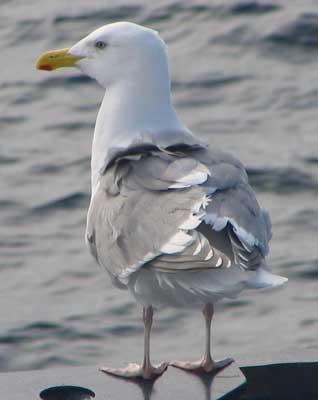Evidence shows that gulls are shifting their diets from marine to terrestrial sources
A 2015 article in the journal Environmental Science and Technology presents additional isotopic evidence that glaucus-winged gulls in the Salish Sea are shifting their diets from marine to terrestrial sources due to human impacts. Scientists hypothesize that declining forage fish may be the cause.

Abstract
Measurements of naturally occurring stable isotopes in tissues of seabirds and their prey are a powerful tool for investigating long-term changes in marine foodwebs. Recent isotopic (δ15N, δ13C) evidence from feathers of Glaucous-winged Gulls (Larus glaucescens) has shown that over the last 150 years, this species shifted from a midtrophic marine diet to one including lower trophic marine prey and/or more terrestrial or freshwater foods. However, long-term isotopic patterns of δ15N and δ13C cannot distinguish between the relative importance of lower trophic-level marine foods and terrestrial sources. We examined 48 feather stable-hydrogen (δ2H) and -sulfur (δ34S) isotope values from this same 150-year feather set and found additional isotopic evidence supporting the hypothesis that gulls shifted to terrestrial and/or freshwater prey. Mean feather δ2H and δ34S values (±SD) declined from the earliest period (1860−1915; n = 12) from −2.5 ± 21.4‰ and 18.9 ± 2.7 ‰, respectively, to −35.5 ± 15.5 ‰ and 14.8 ± 2.4 ‰, respectively, for the period 1980−2009 (n = 12). We estimated a shift of ∼30% increase in dependence on terrestrial/ freshwater sources. These results are consistent with the hypothesis that gulls increased terrestrial food inputs in response to declining forage fish availability.
Citation
Hobson, K.A., Blight, L.K., Arcese, P. (2015). Human-Induced Long-Term Shifts in Gull Diet from Marine to Terrestrial Sources in North America’s Coastal Pacific: More Evidence from More Isotopes (δ2H, δ34S). Enviornmental Science and Technology. DOI: 10.1021/acs.est.5b02053.

